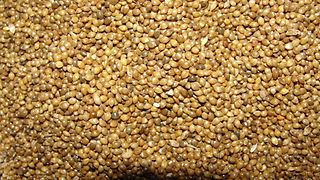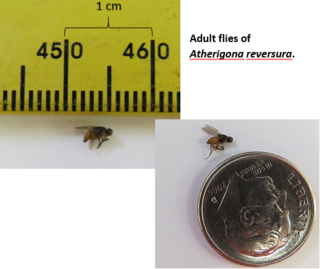
Millets are a highly varied group of small-seeded grasses, widely grown around the world as cereal crops or grains for fodder and human food. Most species generally referred to as millets belong to the tribe Paniceae, but some millets also belong to various other taxa.

Panicum miliaceum is a grain crop with many common names, including proso millet, broomcorn millet, common millet, hog millet, Kashfi millet, red millet, and white millet. Archaeobotanical evidence suggests millet was first domesticated about 10,000 BP in Northern China. Major cultivated areas include Northern China, Himachal Pradesh of India, Nepal, Russia, Ukraine, Belarus, the Middle East, Turkey, Romania, and the Great Plains states of the United States. About 500,000 acres are grown each year. The crop is notable both for its extremely short lifecycle, with some varieties producing grain only 60 days after planting, and its low water requirements, producing grain more efficiently per unit of moisture than any other grain species tested. The name "proso millet" comes from the pan-Slavic general and generic name for millet.

Eleusine coracana, or finger millet, also known as kelvaragu in India, kodo in Nepal, and kurakkan in Sri Lanka, is an annual herbaceous plant widely grown as a cereal crop in the arid and semiarid areas in Africa and Asia. It is a tetraploid and self-pollinating species probably evolved from its wild relative Eleusine africana.

Pearl millet is the most widely grown type of millet. It has been grown in Africa and the Indian subcontinent since prehistoric times. The center of diversity, and suggested area of domestication, for the crop is in the Sahel zone of West Africa. Recent archaeobotanical research has confirmed the presence of domesticated pearl millet on the Sahel zone of northern Mali between 2500 and 2000 BC. 2023 is the International Year of Millets, declared by the United Nations General Assembly in 2021.

Foxtail millet, scientific name Setaria italica, is an annual grass grown for human food. It is the second-most widely planted species of millet, and the most grown millet species in Asia. The oldest evidence of foxtail millet cultivation was found along the ancient course of the Yellow River in Cishan, China, carbon dated to be from around 8,000 years before present. Foxtail millet has also been grown in India since antiquity.

Echinochloa frumentacea is a species of Echinochloa. Both Echinochloa frumentacea and E. esculenta are called Japanese millet. This millet is widely grown as a cereal in India, Pakistan, and Nepal. Its wild ancestor is the tropical grass Echinochloa colona, but the exact date or region of domestication is uncertain. It is cultivated on marginal lands where rice and other crops will not grow well. The grains are cooked in water, like rice, or boiled with milk and sugar. Sometimes it is fermented to make beer. While also being part of staple diet for some communities in India, these seeds are, in particular, eaten during religious fasting. For this reason, these seeds are commonly also referred to as "vrat ke chawal" in Hindi. Other common names to identify these seeds include oodalu (ಊದಲು) in Kannada, Shyamak (শ্যামাক) or Shyama Chal in Bangla, jhangora in the Garhwal Hills, bhagar (भगर) in Marathi-speaking areas, samo or morio seeds in Gujarati, or kuthiraivaali (குதிரைவாளி) in Tamil.

Echinochloa is a very widespread genus of plants in the grass family and tribe Paniceae. Some of the species are known by the common names barnyard grass or cockspur grass.

Paspalum scrobiculatum, commonly called Kodo millet or Koda millet, is an annual grain that is grown primarily in Nepal and also in India, Philippines, Indonesia, Vietnam, Thailand, and in West Africa from where it originated. It is grown as a minor crop in most of these areas, with the exception of the Deccan plateau in India where it is grown as a major food source. It is a very hardy crop that is drought tolerant and can survive on marginal soils where other crops may not survive, and can supply 450–900 kg of grain per hectare. Kodo millet has large potential to provide nourishing food to subsistence farmers in Africa and elsewhere.

Panicum sumatrense, known as little millet, is a species of millet in the family Poaceae.
Coniesta ignefusalis, the pearl millet stem-borer, is a moth in the family Crambidae. It was described by George Hampson in 1919.
The Indian grain aphid, also known as Sitobion (Sitobion) miscanthi, is an aphid in the superfamily Aphidoidea in the order Hemiptera. It is a true bug and sucks sap from cereal plants, making it a pest of wheat production. It has also been recorded as a pest of finger millet, sorghum, and pearl millet in South Asia.

The Millet Network of India supports millet farmers. It was created by one hundred women who realised the qualities of the traditional crop. The group have helped village farmers to grow millet with low water usage and organic fertiliser while highlighting the injustice of government subsidies which encourage competitor crops like rice. It has received both the Nari Shakti Puraskar and the Equator Award.

Atherigona is a genus of flies in the family Muscidae.
Atherigona miliaceae, the finger millet shoot fly, is a species of fly in the family Muscidae. The larvae feed on the central growing shoots of crops such as finger millet, little millet, and proso millet. It is found in East Asia and South Asia.
Atherigona pulla, the proso millet shoot fly, is a species of fly in the family Muscidae. The larvae feed on the central growing shoots of crops such as proso millet and little millet. It is found in South Asia.
Autoba silicula is a species of moth in the family Noctuidae. As a pest of millets, it forms a web in millet earheads and feeds on grains.
Hieroglyphus banian is a species of grasshopper in the family Acrididae. It is a pest of millets such as sorghum, pearl millet, and finger millet in India. It is an annual pest and the eggs require the cycle of dry summer followed by monsoon rains to hatch. The species has an olfactory neuronal pathway remarkably similar to that of Schistocerca.
Hieroglyphus nigrorepletus is a species of grasshopper in the family Acrididae. It is a highly serious pest of millets such as sorghum and pearl millet in western India.

Conocephalus maculatus is a species of bush cricket in the cone head subgenus Anisoptera. It has a widespread distribution in Africa southern and South-East Asia and is a pest of millets and maize in Northeast India. During the summer of 2008, a large swarm severely damaged millet and maize crops in Manipur and Nagaland.










